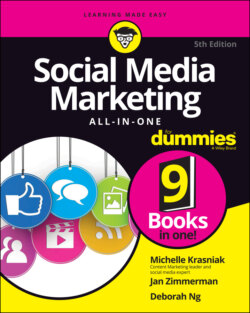Читать книгу Social Media Marketing All-in-One For Dummies - Michelle Krasniak - Страница 49
Geographic location
ОглавлениеMarketing by country, region, state, city, zip code, or even neighborhood is the key for location-based social media outlets, such as Foursquare, or any other form of online marketing that involves local search.
FIGURE 3-1: Quantcast (top) and Alexa (bottom) provide demographic profiles that compare users of a site (in this case, Imgur.com) with the general Internet population.
Geographic segmentation also makes sense if your business draws its primary target audience from within a certain distance from your brick-and-mortar storefront. For example, geographic segmentation makes sense for grocery stores, barbershops, gas stations, restaurants, movie theaters, and many other service providers, whether or not your social media service itself is location-based.
Many social media services offer a location search function to assess the number of users in your geographical target area:
Twitter users near a specified location (
https://twitter.com/search-advanced): To find users within 15 miles of a designated location, click the Add Location pin under Places. Your current location appears. Click the text box to view a list of several nearby communities, as well as a search field. For somewhere farther away, enter the name of the city in the search field and click the blue Search button at the bottom of the page. On the search results page that appears, you’ll see Who to Follow and Trends options in the left column. To alter the 15-mile default distance, change the mileage display in the gray search box at the very top of the results page.LinkedIn users within a certain radius (
www.linkedin.com/search): In the Location drop-down list in the left column, select Located In or Near. Additional options appear, including a Country drop-down list, a Postal Code text box, and a Within drop-down list, with choices of radius from 10 to 100 miles. After clicking Search, the number of results appears at the top left of the center column, above the list of names. You can filter further by the degree of connection, if you want.Facebook users near a certain location (
www.facebook.com): The most accurate way to size a potential target audience geographically is to create a Facebook advertising account with a test ad, which you may choose not to launch. Log in as the admin for your page. Click the drop-down arrow in the right corner of the top navigation, and then click Create Ads. Follow the prompts to create an account and choose an objective for an ad. (For audience research, it doesn’t matter which objective you select.) Now click Audience in the Ad Set section of the left column that appears. In the center column, choose Everyone in This Location, and specify the geographical region you want. For the total number of Facebook users, avoid setting any demographic or other parameters. At the top of the right column, find the Audience Definition dial display. Below the dial is a numerical value for potential reach, which is the total number of Facebook users in the location you requested. For more information, see the section on Facebook advertising in Book 5, Chapter 3.
If you can’t determine the number of potential users for a social media channel in your specific geographic location, use the Help function on the social media channel, check the blog, or contact the company.
Several companies combine geographical information with demographics and behavioral characteristics to segment the market more finely. For example, the Nielsen PRIZM system offers demo-geographic data organized into 66 distinct sub-segments, some of which are described in Table 3-1.
TABLE 3-1 Top-Level Demo-Geographic Social Groups from Nielsen PRIZM
| Name | Description |
|---|---|
| Urban Uptown | Wealthiest urban (highest density) consumers (five sub-segments) |
| Midtown Mix | Midscale, ethnically diverse, urban population (three sub-segments) |
| Urban Cores | Modest income, affordable housing, urban living (four sub-segments) |
| Elite Suburbs | Affluent, suburban elite (four sub-segments) |
| Affluentials | Comfortable suburban lifestyle (six sub-segments) |
| Middleburbs | Middle-class suburbs (five sub-segments) |
| Inner Suburbs | Downscale inner suburbs of metropolitan areas (four sub-segments) |
| Second City Society | Wealthy families in smaller cities on fringes of metro areas (three sub-segments) |
| City Centers | Low income, satellite cities with mixed demographics (five sub-segments) |
| Micro-City Blues | Downscale residents in second cities (five sub-segments) |
| Landed Gentry | Wealthy Americans in small towns (five sub-segments) |
| Country Comfort | Upper-middle-class homeowners in bedroom communities (five sub-segments) |
| Middle America | Middle-class homeowners in small towns and exurbs (six sub-segments) |
| Rustic Living | Most isolated towns and rural areas (six sub-segments) |
Reproduced with permission of The Nielsen Company; Source: Nielsen Claritas
